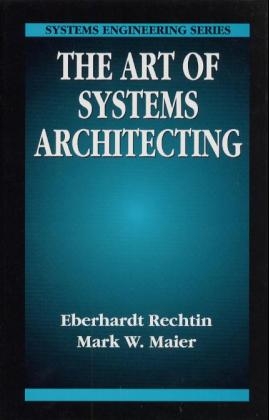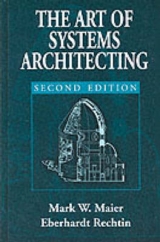
The Art of Systems Architecting
Crc Press Inc (Verlag)
978-0-8493-7836-2 (ISBN)
- Titel erscheint in neuer Auflage
- Artikel merken
The Art of Systems Architecting is for present and future systems architects, for experienced engineers and managers interested in extending their expertise beyond a single field, and for individuals concerned with creating, building, or using complex systems. This innovative text directly addresses the problems inherent in creating and building new and complex systems for electronics, computer, software, aerospace, and government purposes. Today's challenges demand that a new class of tools, heuristic and qualitative, be added to the familiar ones of analysis and optimization. Today's architecting must handle the types of systems that have been unknown until very recently, e.g., systems that are very high-quality, real-time, closed-loop, reconfigurable, interactive, software-intensive, and, for all practical purposes, autonomous. The Art of Systems Architecting provides these tools by introducing the non-qualitative architectural concepts of systems thinking, heuristics, tensions, feedback architectures, modeling, and progressive design. Move beyond the traditional science of systems engineering and into the complementary art of architecting. It's all waiting for you in this one-of-a-kind book.
PART ONE: THE ART OF ARCHITECTING
Introduction
Chapter 1. Extending the Architecting Paradigm
Introduction: The Classical Architecting Paradigm
The Foundations of Modern Systems Architecting
The Waterfall Model of Systems Architecting
Summary and Conclusions
Notes and References
Chapter 2. Heuristic as Tools
Introduction: A Metaphor
Heuristics as Abstractions of Experience
Selecting a Personal Kit of Heuristic Tools
Heuristics on Heuristics
A Taxonomy of Heuristics
Summary
Notes and References
PART TWO: NEW DOMAINS, NEW INSIGHTS
Chapter 3. Builder-Architected Systems
Introduction: The Form-First Paradigm
Form-First Systems
Reducing the Risks of Uncertainty of End Purpose
The "What Next" Quandary
Creating Innovative Teams
Systems Architecting and Basic Research
Heuristics for Technology-Driven Systems
Summary
Exercises
Notes and References
Chapter 4. Manufacturing Systems
Introduction: The Manufacturing Domain
Architectural Innovations in Manufacturing
Heuristics for Architecting Manufacturing Systems
In Conclusion
Exercises
Notes and References
Chapter 5. Social Systems
Introduction: Defining Sociotechnical Systems
The Foundations of Sociotechnical Systems Architecting
The Interaction Between the Public and Private Sectors
Facts vs. Perceptions: An Added Tension
Heuristics for Social Systems
In Conclusion
Exercises
Notes and References
Chapter 6. Software Systems
Introduction: The Status of Software Architecting
Software as a Systems Component
Software for Modern Systems
Systems, Software, and Process Models
The Role of Architecture in Software-Centered Systems
Directions in Software Architecting
Heuristics and Guidelines in Software
Exercises
Notes and References
Exercise to Close Part Two
PART THREE: MODELS AND MODELING
Chapter 7. Representation Models and System Architecting
Introduction: Roles, Views, and Models
Roles of Models
Classification of Models by View
Examples of Integrated Models
Summary
Exercises
Notes and References
Chapter 8. Design Progression in System Architecting
Introduction: Architecting Process Components
Design Concepts for Systems Architecture
Design Progression
Architecture and Design Disciplines
Conclusions
Exercises
Notes and References
Chapter 9. Integrated Modeling Methodologies
Introduction
General Integrated Models
Integrated Modeling and Software
Integrated Models for Manufacturing Systems
Integrated Models for Sociotechnical Systems
Conclusions
Exercises
Notes and References
PART FOUR: THE SYSTEMS ARCHITECTING PROFESSION
Chapter 10. The Political Process and Systems Architecting
Introduction: The Political Challenge
Politics as a Design Factor
The First Skill to Master
Heuristics in the Political Process: "The Facts of Life"
A Few More Skills to Master
Conclusion
Chapter 11. The Professionalization of Systems Architecting
Introduction
The Profession of Systems Engineering
Systems Architecting and Systems Standards
Systems Architecting Graduate Education
Professional Societies and Publications
Conclusion: An Assessment of the Profession
Notes and References
APPENDICES
Appendix: Heuristics for Systems-Level Architecting
Introduction: Organizing the List
Heuristic Tool List
Exercises
Notes and References
Glossary
Index by Author
Index by Subject
| Erscheint lt. Verlag | 19.11.1996 |
|---|---|
| Reihe/Serie | Systems Engineering |
| Verlagsort | Bosa Roca |
| Sprache | englisch |
| Maße | 156 x 235 mm |
| Gewicht | 526 g |
| Einbandart | gebunden |
| Themenwelt | Mathematik / Informatik ► Informatik ► Theorie / Studium |
| Informatik ► Weitere Themen ► Hardware | |
| ISBN-10 | 0-8493-7836-2 / 0849378362 |
| ISBN-13 | 978-0-8493-7836-2 / 9780849378362 |
| Zustand | Neuware |
| Haben Sie eine Frage zum Produkt? |
aus dem Bereich



